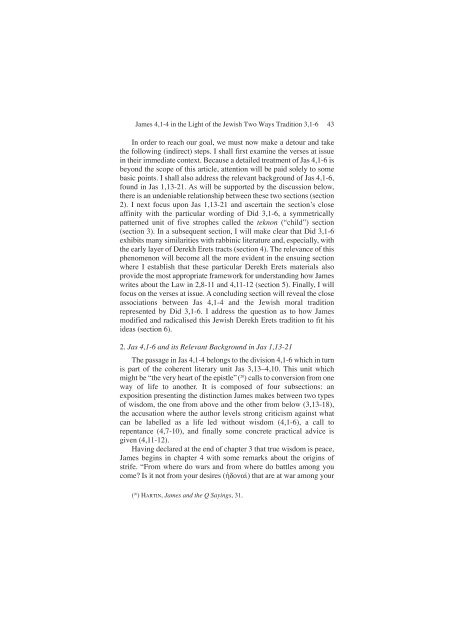James 4,1-4 in the Light of the Jewish Two Ways Tradition 3,1-6
James 4,1-4 in the Light of the Jewish Two Ways Tradition 3,1-6
James 4,1-4 in the Light of the Jewish Two Ways Tradition 3,1-6
You also want an ePaper? Increase the reach of your titles
YUMPU automatically turns print PDFs into web optimized ePapers that Google loves.
<strong>James</strong> 4,1-4 <strong>in</strong> <strong>the</strong> <strong>Light</strong> <strong>of</strong> <strong>the</strong> <strong>Jewish</strong> <strong>Two</strong> <strong>Ways</strong> <strong>Tradition</strong> 3,1-6 43<br />
In order to reach our goal, we must now make a detour and take<br />
<strong>the</strong> follow<strong>in</strong>g (<strong>in</strong>direct) steps. I shall first exam<strong>in</strong>e <strong>the</strong> verses at issue<br />
<strong>in</strong> <strong>the</strong>ir immediate context. Because a detailed treatment <strong>of</strong> Jas 4,1-6 is<br />
beyond <strong>the</strong> scope <strong>of</strong> this article, attention will be paid solely to some<br />
basic po<strong>in</strong>ts. I shall also address <strong>the</strong> relevant background <strong>of</strong> Jas 4,1-6,<br />
found <strong>in</strong> Jas 1,13-21. As will be supported by <strong>the</strong> discussion below,<br />
<strong>the</strong>re is an undeniable relationship between <strong>the</strong>se two sections (section<br />
2). I next focus upon Jas 1,13-21 and ascerta<strong>in</strong> <strong>the</strong> section’s close<br />
aff<strong>in</strong>ity with <strong>the</strong> particular word<strong>in</strong>g <strong>of</strong> Did 3,1-6, a symmetrically<br />
patterned unit <strong>of</strong> five strophes called <strong>the</strong> teknon (“child”) section<br />
(section 3). In a subsequent section, I will make clear that Did 3,1-6<br />
exhibits many similarities with rabb<strong>in</strong>ic literature and, especially, with<br />
<strong>the</strong> early layer <strong>of</strong> Derekh Erets tracts (section 4). The relevance <strong>of</strong> this<br />
phenomenon will become all <strong>the</strong> more evident <strong>in</strong> <strong>the</strong> ensu<strong>in</strong>g section<br />
where I establish that <strong>the</strong>se particular Derekh Erets materials also<br />
provide <strong>the</strong> most appropriate framework for understand<strong>in</strong>g how <strong>James</strong><br />
writes about <strong>the</strong> Law <strong>in</strong> 2,8-11 and 4,11-12 (section 5). F<strong>in</strong>ally, I will<br />
focus on <strong>the</strong> verses at issue. A conclud<strong>in</strong>g section will reveal <strong>the</strong> close<br />
associations between Jas 4,1-4 and <strong>the</strong> <strong>Jewish</strong> moral tradition<br />
represented by Did 3,1-6. I address <strong>the</strong> question as to how <strong>James</strong><br />
modified and radicalised this <strong>Jewish</strong> Derekh Erets tradition to fit his<br />
ideas (section 6).<br />
2. Jas 4,1-6 and its Relevant Background <strong>in</strong> Jas 1,13-21<br />
The passage <strong>in</strong> Jas 4,1-4 belongs to <strong>the</strong> division 4,1-6 which <strong>in</strong> turn<br />
is part <strong>of</strong> <strong>the</strong> coherent literary unit Jas 3,13–4,10. This unit which<br />
might be “<strong>the</strong> very heart <strong>of</strong> <strong>the</strong> epistle”( 20 ) calls to conversion from one<br />
way <strong>of</strong> life to ano<strong>the</strong>r. It is composed <strong>of</strong> four subsections: an<br />
exposition present<strong>in</strong>g <strong>the</strong> dist<strong>in</strong>ction <strong>James</strong> makes between two types<br />
<strong>of</strong> wisdom, <strong>the</strong> one from above and <strong>the</strong> o<strong>the</strong>r from below (3,13-18),<br />
<strong>the</strong> accusation where <strong>the</strong> author levels strong criticism aga<strong>in</strong>st what<br />
can be labelled as a life led without wisdom (4,1-6), a call to<br />
repentance (4,7-10), and f<strong>in</strong>ally some concrete practical advice is<br />
given (4,11-12).<br />
Hav<strong>in</strong>g declared at <strong>the</strong> end <strong>of</strong> chapter 3 that true wisdom is peace,<br />
<strong>James</strong> beg<strong>in</strong>s <strong>in</strong> chapter 4 with some remarks about <strong>the</strong> orig<strong>in</strong>s <strong>of</strong><br />
strife. “From where do wars and from where do battles among you<br />
come? Is it not from your desires (hJdonaiv) that are at war among your<br />
( 20 ) HARTIN, <strong>James</strong> and <strong>the</strong> Q Say<strong>in</strong>gs, 31.


